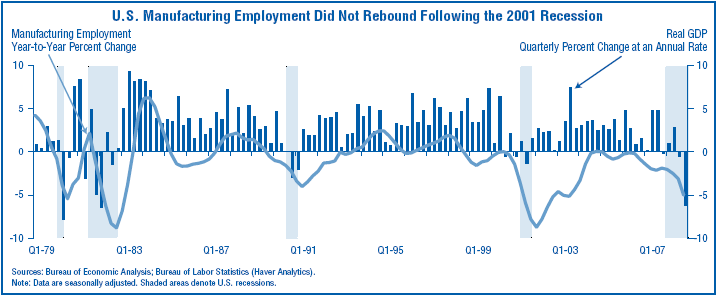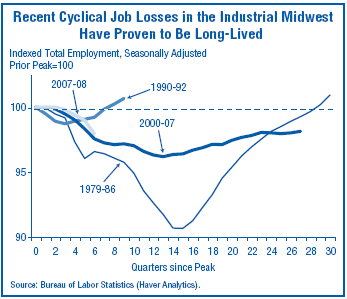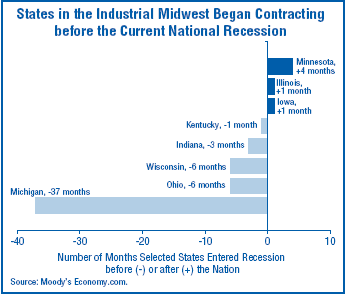|
Home > Industry Analysis > Research & Analysis > FDIC Quarterly |
|||
|
FDIC: Feature Article The 2009 Economic Landscape Recession Adds to Long-Term Manufacturing Challenges in the Industrial Midwest The manufacturing sector has long been a primary economic driver of the Industrial Midwest.1 This region, which comprises eight states in the north-central United States, is known for its durable goods manufacturing, a sector that includes the production of automobiles and other types of heavy machinery. The emphasis on manufacturing has posed challenges for the region as the sector has contracted. This article discusses manufacturing trends in the Industrial Midwest, particularly with respect to the troubled auto sector, and the economic outlook for the region. The Industrial Midwest Has Not Recovered from the Last Recession The U.S. manufacturing sector has struggled throughout this decade. Historically, nationwide manufacturing-related employment has tended to decline a few quarters before the U.S. economy contracts and then recover in tandem with the broader economy. However, job growth in the U.S. manufacturing sector did not rebound after the 2001 recession, even while overall U.S. economic growth was strong (see Chart 1).2 Chart 1  d
d
These manufacturing weaknesses have had a disproportionate effect on the Industrial Midwest economy. In each state in the region, manufacturing employment as a percentage of total employment is higher than the nation's. Moreover, Indiana, Wisconsin, Michigan, and Ohio have the highest concentrations of manufacturing employment in the country.3 Because of its reliance on manufacturing during a period of weakness in this sector, total employment in the region has yet to return to pre-2001 levels (see Chart 2). Chart 2  d
d
Two long-term issues are adversely affecting manufacturing in the Industrial Midwest. First, over the past two decades, much of the region's manufacturing base has been lost to competition, both foreign and domestic. Second, technological improvements in U.S. factories have led to much higher productivity levels.4 These productivity advances have been brought about by capital investments that require fewer low-skilled workers. More recently, the erosion of market share and structural cost problems at General Motors (GM), Chrysler, and Ford have led to large-scale restructurings and job losses. These challenges at U.S. automakers have contributed to the loss of more than 140,000 manufacturing jobs since 2005.5 Hundreds of thousands of additional workers at auto assembly plants and auto parts suppliers could potentially lose their jobs during the current downturn.6 Auto sector layoffs have disproportionately affected Michigan, Ohio, and Indiana, the states most exposed to the troubled auto sector. These states were essentially in recession before the nation as a whole, with Michigan preceding the national downturn by more than three years (see Chart 3). Michigan is the state most heavily concentrated in auto manufacturing, with the most motor vehicle manufacturing jobs and the highest number and proportion of direct and indirect jobs connected to motor vehicle parts production.7 Chart 3  d
d
Employment Weakness Has Also Spilled into the Region's Housing Markets Although the Industrial Midwest did not experience the significant home price appreciation of the post-2001 housing boom to the same degree as other regions, its residential real estate markets have still suffered. Existing home sales in the Industrial Midwest declined 33 percent from their second quarter 2005 peak, roughly in line with the nationwide decline.8 In 2008, home prices fell in all of the region's states, led by Michigan, where prices declined by more than 10 percent.9 Further, in half of the Industrial Midwest states, foreclosure rates are at or slightly higher than the national rate.10 Weak housing markets have, in turn, adversely affected the region's construction industry. Construction employment was virtually unchanged across the Industrial Midwest from 2003 through 2006, while it grew more than 10 percent nationwide. Since 2006, the construction sector in the Industrial Midwest has declined by 7.7 percent, or 96,000 jobs. The Industrial Midwest Faces a Potentially Long Road to Recovery Employment in the Industrial Midwest has declined substantially during the current downturn, and the near-term outlook for Detroit's auto industry remains unclear. Automakers have been shrinking their businesses to match reduced market share. In addition, financial press reports and analytical studies indicate that hundreds of thousands of jobs are potentially at stake as Chrysler and GM continue to negotiate restructuring plans with the Obama administration's auto task force. Though foreign-based automakers with production facilities in the region might increase output to partially offset this gap, their new hiring likely would not fully absorb jobs shed by Detroit automakers. Two other economic indicators also point to a prolonged path to recovery. First, the outlook for the metal fabrication and machinery manufacturing industries has diminished. These industries, which include companies involved in the transformation of metal into intermediate or final products and the production of machines used in industrial applications, provided some economic stability to the Industrial Midwest following the last recession. However, the weakening national economy has softened demand for their products. Nationally, investment in machinery and other fixed assets has slowed consistently since mid-2007, and fell 21 percent during fourth quarter 2008.11 As a result, employment in fabrication and machinery manufacturing in the region declined 1.4 percent, or about 13,000 jobs, in 2008. Second, contraction or slowing growth in the economies of U.S. trading partners will likely limit future export opportunities that had provided a counterbalance to the weakened auto sector over the past few years. Exports rose 13 percent and 11 percent, respectively, in 2006 and 2007, benefiting from strong foreign demand and a decline in the value of the dollar. However, the economies of foreign trading partners are now slowing or contracting and the decline in the dollar has reversed direction, returning to trade-weighted levels not seen since 2006.12 A more positive outlook for the region hinges in no small part on the success of federal government initiatives directed at stimulating the economy in general and the auto sector in particular. Spending on infrastructure projects should generate new jobs, while other provisions of the $787 billion American Recovery and Reinvestment Act are intended to maintain existing jobs. However, most of the affected jobs will be outside of the manufacturing sector. While employment will likely continue to decline in the automotive sector, it is likely that fewer jobs would be lost under a government-assisted restructuring than would occur otherwise. Over the long term, job growth is likely to become more dependent on emerging and expanding industries, such as those found in the energy, education, and health care sectors. Authors: 1 In this article, the Industrial Midwest is defined as the region encompassing Indiana, Wisconsin, Michigan, Ohio, Iowa, Kentucky, Minnesota, and Illinois. 2 The trend of outsourcing may contribute to overcounting of manufacturing job losses. As manufacturers "purchase" a growing number of services, the value of which is ultimately embedded in product value, manufacturing employment levels may have simply shifted to service industry sectors. See "Is Manufacturing at a Crossroads?" Chicago Fed Letter, Number 204a, July 2004. 3 Bureau of Labor Statistics, December 31, 2008. Manufacturing concentrations are defined as durable goods manufacturing and wholesale trade jobs as a percentage of total nonfarm payrolls. 4 Bureau of Labor Statistics. From 2002 to 2006, U.S. manufacturing multifactor productivity growth—the increase in the ratio of goods output to labor, capital, and other inputs—averaged 2.2 percent, well above the 30-year average of 1.4 percent. 5 The figure cited refers to job losses in the transportation manufacturing sector of the Industrial Midwest through 2008. These job losses have occurred mostly at auto parts suppliers and automakers. 6 See CAR Research Memorandum: The Impact on the U.S. Economy of a Major Contraction of the Detroit Three Automakers, Center for Automotive Research, November 4, 2008. 7 Contribution of the Motor Vehicle Supplier Sector to the Economies of the United States and Its 50 States, Center for Automotive Research, January 2007. 8 National Association of Realtors, data available as of fourth quarter 2008. 9 Based on the Federal Housing Finance Agency Purchase-Only House Price Index. 10 Mortgage Bankers Association, fourth quarter 2008. 11 Bureau of Economic Analysis; seasonally adjusted, annualized growth in real private nonresidential fixed investment. 12 The Blue Chip Economic Indicators consensus forecast as of December 2008 calls for a 0.1 percent decline in Canada's GDP in 2009 and only a 0.2 percent increase in Mexico's GDP. Growth in China, one of the fastest growing export markets, is expected to slow from 9.5 percent in 2008 to 7.6 percent in 2009, well below trend. |
||
| Last Updated 04/27/2009 | Questions, Suggestions, and Requests | |
| Home Contact Us Search Help SiteMap Forms Freedom of Information Act (FOIA) Service Center Website Policies USA.gov |
| FDIC Office of Inspector General |